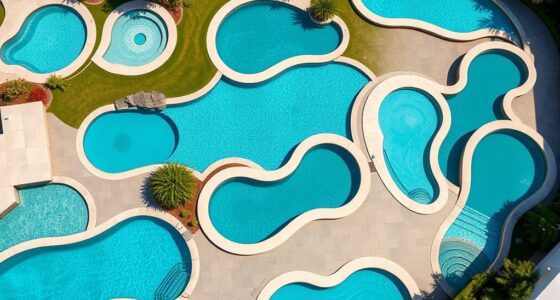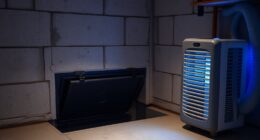To keep your endless pool in top shape, you should check and adjust the water level daily, ensuring it’s at the proper height. Test your water chemistry every day and balance the pH, chlorine, and alkalinity levels. Regularly skim debris, brush surfaces, and clean the waterline to prevent buildup. Backwash your filter weekly and inspect your pump and equipment for issues. Staying consistent with these tasks helps maintain clarity and performance—continue for more helpful tips.
Key Takeaways
- Regularly check and maintain the water level to prevent pump damage and ensure proper filtration.
- Test and balance water chemistry daily, focusing on pH, chlorine, alkalinity, and cyanuric acid levels.
- Skim debris from the surface and brush pool surfaces weekly to prevent algae buildup and keep water clear.
- Backwash the filter weekly when pressure rises 8-10 psi above normal to maintain optimal filtration.
- Inspect and clean equipment, including pumps and hoses, regularly to prevent leaks and ensure efficient operation.
Checking and Adjusting Water Level
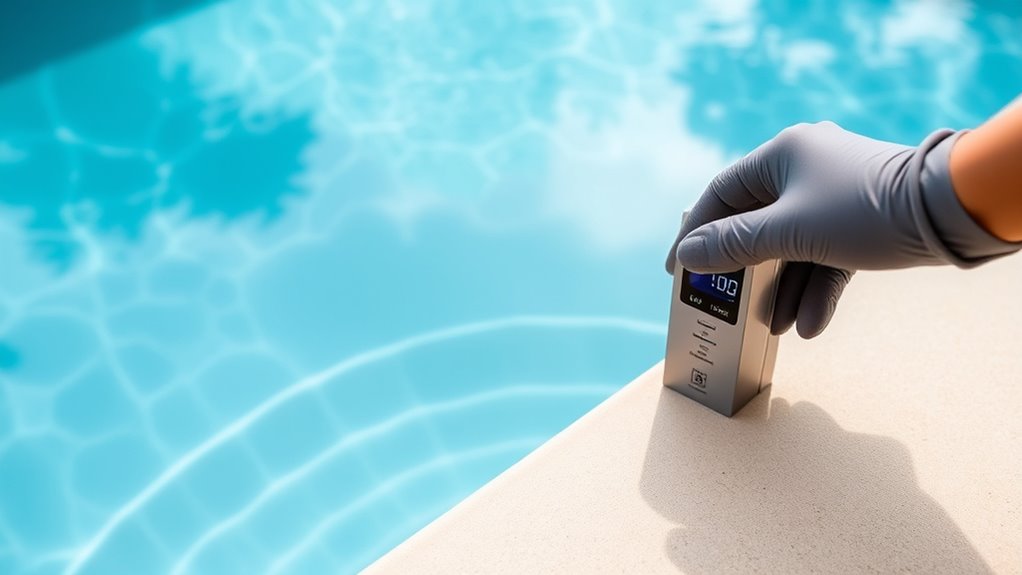
To guarantee your pool stays clean and safe to swim in, you need to regularly check and adjust the water level. Start by observing if the water is at the proper height, which is typically marked on the pool’s skimmer or edge. If the water drops below the skimmer opening, it can cause the pump to run dry, damaging the system. Conversely, if it’s too high, water may splash out and affect filtration. To correct this, use a garden hose to add water or drain excess water with a sump pump or bucket. Keep the water level consistent, especially after heavy use or rain, to ensure your pool’s filtration and circulation work efficiently. Regular checks prevent costly repairs and maintain ideal swimming conditions. Additionally, understanding the contrast ratio of your filtration system can help optimize its performance and longevity.
Testing Water Chemistry Daily

After ensuring your pool’s water level stays consistent, regularly testing the water chemistry is the next step to keep it safe and inviting. Daily testing helps you catch imbalances early, preventing issues like algae growth or equipment damage. To keep things simple, focus on these four key parameters:
- pH level – Maintain between 7.2 and 7.8 to prevent skin irritation and equipment corrosion.
- Chlorine levels – Keep between 1 and 3 ppm for effective sanitation.
- Total alkalinity – Keep within 80-120 ppm to stabilize pH.
- Cyanuric acid – Maintain at 30-50 ppm to protect chlorine from UV degradation.
Regular checks allow you to make quick adjustments, ensuring your pool stays crystal clear and safe for swimming. Monitoring water chemistry helps maintain a healthy and balanced pool environment.
Skimming and Removing Debris

Keeping the pool surface clear makes your swim more enjoyable and safer. Use a skimmer net regularly to remove floating debris and prevent buildup. By staying on top of these tasks, you’ll maintain a clean, inviting pool.
Clear Surface Regularly
Regularly skimming the surface of your pool helps keep debris like leaves, insects, and dirt from sinking to the bottom and clouding the water. This simple task prevents buildup that can affect water quality and circulation. To stay ahead, consider these key points:
- Consistency is essential—skim daily during peak use or when debris is visible.
- Use a sturdy net to catch floating debris effectively.
- Pay attention to wind-driven leaves and insects, which tend to gather at the surface.
- Regular surface cleaning reduces strain on your filtration system and keeps the water clear.
Use Skimmer Net
Using a skimmer net is one of the most effective ways to remove debris from your pool’s surface. It helps prevent dirt, leaves, insects, and other debris from sinking to the bottom, which can cause stains or clog your pump. To use it, simply drag the net across the water’s surface, focusing on areas with visible debris. Be gentle to avoid disturbing the water too much. Regular skimming keeps your pool looking clean and reduces the workload of your filtration system. For best results, do this daily, especially during windy days or when trees shed leaves nearby. Keep your skimmer net clean by rinsing it after each use, so it’s ready for the next session and remains effective.
Remove Floating Debris
Removing floating debris from your pool’s surface is a straightforward way to maintain its cleanliness and appearance. Regular skimming prevents debris from sinking and affecting water quality. To do this effectively, keep in mind these key steps:
- Use a skimmer net daily to catch leaves, insects, and other floating particles.
- Focus on 1-3 areas that gather debris, such as corners or near trees.
- Check for larger debris that may clog filters or skimmers.
- Rinse the net after each use to prevent spreading dirt back into the pool.
- Incorporate routine pool maintenance to keep your pool in optimal condition.
Brushing the Pool Surfaces
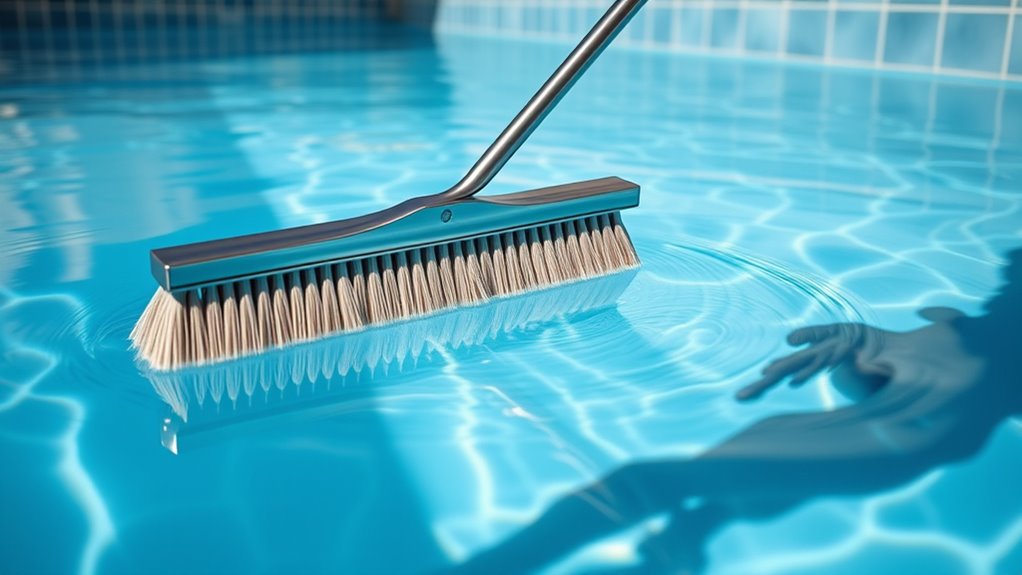
Brushing the pool surfaces is essential for maintaining a clean and healthy swimming environment. Regular brushing prevents algae buildup and removes dirt that can stick to the walls and floor. Use a pool brush designed for your surface type—stainless steel for concrete, nylon for vinyl or fiberglass. Start at one end of the pool and work systematically to cover all areas. Focus on the walls, floor, and steps, paying extra attention to corners and crevices where debris tends to accumulate. Brushing helps keep the surfaces smooth, reducing algae growth and making chemical balancing more effective. Proper surface maintenance enhances the longevity of your pool and ensures a safer swimming experience. Make brushing a part of your routine, ideally at least once a week, to keep your pool looking crystal clear and feeling inviting.
Cleaning the Waterline
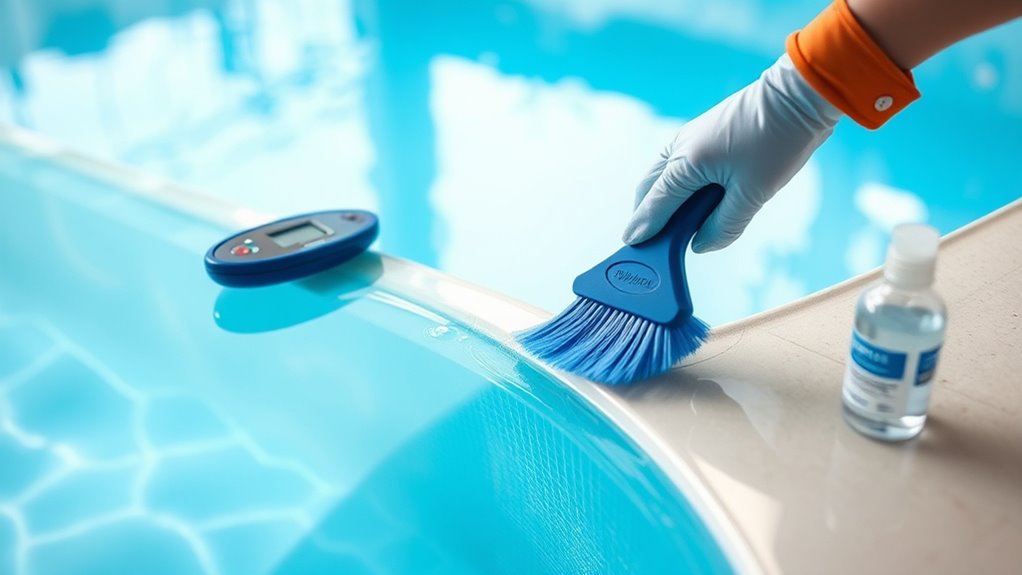
To keep your pool looking its best, you should regularly wipe down the waterline to prevent buildup. Using the right cleaning tools helps remove mineral deposits before they become stubborn stains. Consistent maintenance guarantees your pool stays clean and inviting for every swim. Incorporating essential oils for maintenance can also help in preventing mold and bacteria growth around the waterline.
Regular Waterline Wiping
Regular waterline wiping is essential for keeping your pool looking clean and preventing buildup of algae, dirt, and oils. Regularly wiping the waterline helps maintain clarity and prevents stubborn stains. To do it effectively:
- Use a soft cloth or sponge to avoid scratching the surface.
- Apply a gentle, non-abrasive cleaner or vinegar solution.
- Focus on areas with visible grime or discoloration.
- Rinse thoroughly with clean water afterward.
This simple routine ensures your pool appears inviting and reduces the chances of algae growth. Consistent wiping also extends the life of your pool’s surface and keeps maintenance easier over time. Remember, a clean waterline isn’t just aesthetic—it’s a crucial step in overall pool health. Staying vigilant about pool surface care can significantly improve your maintenance routine.
Preventing Mineral Deposits
Mineral deposits can quickly accumulate along the waterline if not addressed, creating stubborn stains that are difficult to remove later. To prevent this, regularly wipe the waterline with a soft cloth or sponge to remove buildup before it hardens. Maintain proper water chemistry by testing and balancing your pool’s pH and alkalinity levels, as imbalanced water encourages mineral deposits. Consider using a sequestrant or metal remover designed to bind minerals in the water, preventing deposits from forming on surfaces. Keep your pool’s filtration system clean and functioning properly to reduce mineral content in the water. Consistent maintenance helps keep mineral deposits at bay, saving you time and effort in the long run. Staying proactive ensures your pool stays clear and inviting, with minimal stubborn stains.
Proper Cleaning Tools
Using the right cleaning tools makes removing debris and stains from the waterline easier and more effective. A good scrub brush or sponge with a long handle helps reach stubborn buildup without straining. A gentle, non-abrasive cleaner prevents damage while loosening dirt. A microfiber cloth is perfect for wiping away residue without scratching surfaces. Ultimately, a waterline scraper or razor blade can carefully remove stubborn mineral deposits or algae. Properly selecting cleaning techniques ensures thorough maintenance and prolongs the lifespan of your pool equipment. Remember these key tools: 1. Scrub brush or sponge 2. Non-abrasive cleaner 3. Microfiber cloth 4. Waterline scraper or razor blade Having the right tools ensures you maintain a clean, clear waterline, preventing buildup that can affect water quality and pool aesthetics. Proper equipment makes all the difference.
Backwashing and Filter Maintenance
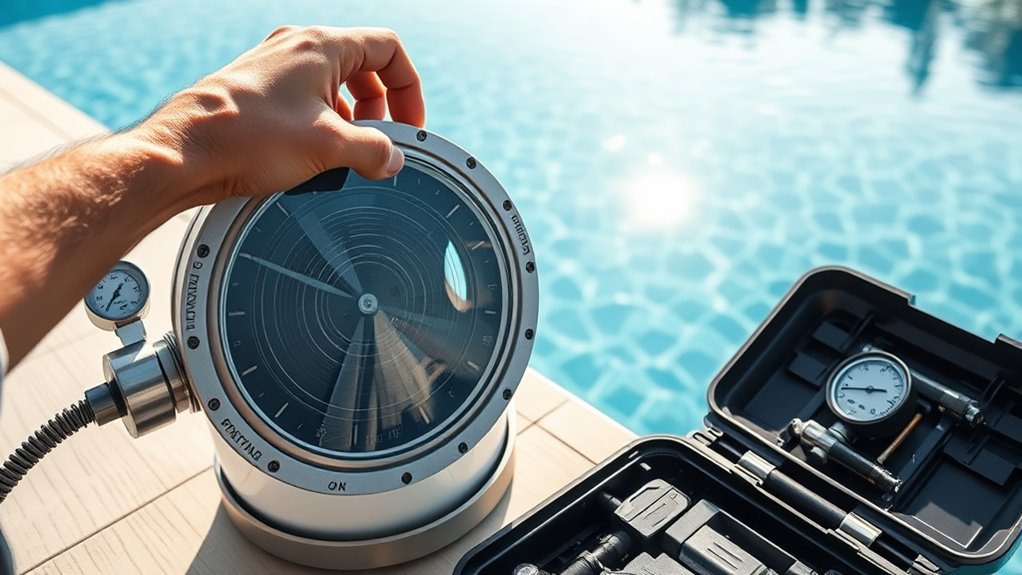
Backwashing the filter is a crucial step to keep your pool clean and guarantee ideal water flow. Over time, debris, dirt, and oils clog the filter, reducing its efficiency. To backwash, turn off the pool pump, then set the filter valve to the backwash position. Turn the pump back on and let it run for 2-3 minutes until the water runs clear. Turn off the pump again and return the valve to the normal filter position. Regular backwashing prevents pressure buildup, prolongs filter life, and maintains water clarity. Check your filter’s pressure gauge; when it rises 8-10 psi above the normal operating level, it’s time to backwash. Incorporating this routine weekly helps maintain optimal equipment functionality and ensures your pool remains crystal clear.
Inspecting and Maintaining the Pump and Equipment

Regularly inspecting and maintaining your pool’s pump and equipment is essential to guarantee everything runs smoothly and efficiently. By staying proactive, you prevent costly repairs and ensure peak performance. Here are four key steps:
- Check for leaks or unusual noises – Identify issues early to avoid system failure.
- Inspect and clean the pump basket – Remove debris that can hinder water flow.
- Examine hoses and fittings – Tighten or replace any worn or damaged parts.
- Monitor pressure gauges – Ensure pressure stays within recommended levels to maintain proper circulation.
Maintaining awareness of angel number meanings related to your love life can also foster a positive mindset, encouraging patience and trust in the process.
Performing these simple tasks regularly keeps your equipment in top shape, extends its lifespan, and maintains clean, clear water. Staying vigilant guarantees your pool remains inviting and trouble-free.
Weekly Deep Cleaning and System Checks
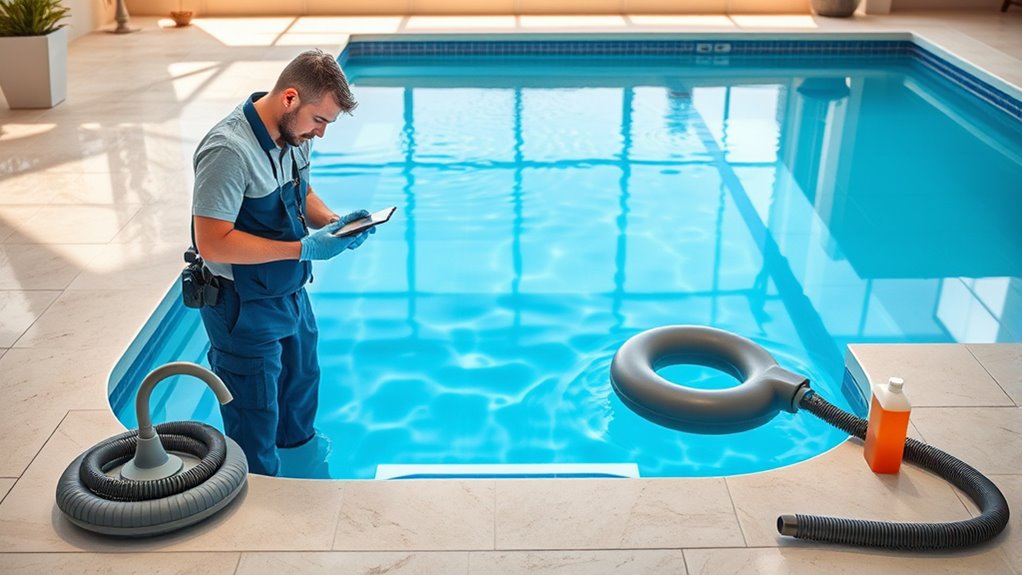
To keep your pool in ideal condition, it’s crucial to perform weekly deep cleaning and system checks. Begin by skimming the surface to remove debris and brushing the walls and floor to prevent algae buildup. Next, drain and clean the filter components, ensuring they’re free of dirt and debris for optimal operation. Check your pump and filtration system for leaks, unusual noises, or signs of wear, and tighten any loose fittings. Inspect the hoses and connections for cracks or blockages. Test the water’s pH and sanitizer levels, adjusting as necessary to maintain proper chemical balance. Additionally, maintaining proper chemical balance is vital to prevent corrosion or scaling. Finally, verify that all equipment, including the heater and jets, functions correctly. Regular deep cleaning keeps your endless pool sparkling and running smoothly, extending its lifespan and ensuring a safe, enjoyable swim every time.
Frequently Asked Questions
How Often Should I Replace the Pool’s Filter Media?
You should replace your pool’s filter media every 6 to 12 months, depending on usage and water quality. Regularly check the filter for signs of wear or clogging, and clean it as needed between replacements. If you notice decreased water flow or cloudy water, it’s time to swap out the media. Proper maintenance guarantees your pool stays clean, clear, and inviting all season long.
What Are the Signs of a Failing Pump?
Did you know that about 20% of pool pump failures are caused by overlooked signs? If your pump makes unusual noises, struggles to circulate water, or stops unexpectedly, it’s likely failing. You might notice reduced water flow or increased energy bills too. These signs mean you should check your pump’s motor and impeller promptly. Addressing issues early can save you from costly repairs and keep your pool running smoothly.
How Can I Prevent Algae Growth in My Endless Pool?
To prevent algae growth in your endless pool, you should maintain proper chemical balance, especially chlorine levels, to keep the water sanitized. Regularly test and adjust pH and alkalinity, and run the filter daily to circulate the water. Brushing the walls and using algaecide weekly can also help. Keep the pool covered when not in use to minimize exposure to debris and sunlight, which promote algae growth.
Is It Necessary to Drain and Refill the Pool Regularly?
No, you don’t need to drain and refill your pool regularly—unless you want to. Most pools stay clean and balanced with proper filtration, shocking, and water testing. Draining too often can actually cause more harm than good, like damaging your pool’s structure or wasting water. Instead, focus on regular maintenance, balancing chemicals, and keeping the filter clean. That way, your pool stays fresh without unnecessary draining.
What Safety Precautions Should I Follow During Maintenance?
During maintenance, you should turn off the power and disconnect the equipment to prevent electrical hazards. Always wear gloves and eye protection to avoid contact with chemicals. Make certain the area is well-ventilated when handling cleaning agents. Keep children and pets away from the pool and chemicals. Follow manufacturer instructions carefully, and never mix chemicals, as this can cause dangerous reactions. Prioritize safety to prevent accidents and injuries.
Conclusion
By staying consistent with these daily and weekly maintenance tasks, you’ll keep your endless pool sparkling and running smoothly. But don’t forget—ignoring even one step can lead to surprises you didn’t see coming. Are you prepared to handle potential issues before they become costly problems? Keep up with your routine, stay vigilant, and you’ll enjoy endless, worry-free swimming. The secret to a perfect pool is in your hands—are you ready to master it?





